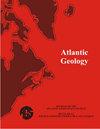Late Wisconsinan and Holocene development of Grand Lake Meadows area and southern reaches of the Saint John River Valley, New Brunswick, Canada
IF 0.9
4区 地球科学
Q2 GEOLOGY
引用次数: 5
Abstract
A 67 m near-continuous stratigraphic core was recovered from drilling at Grand Lake Meadows, located near the junction of Grand Lake and the Saint John River, approximately 40 km south of Fredericton, New Brunswick. From analyses of recovered samples and finite radiocarbon dating, four phases of development of the study site and surrounding environs were identified to have occurred following the Late Wisconsinan glacial maximum. Phase I, related to the formation of the DeGeer Sea, commenced more than 15 000 calyBP from deglaciation accompanied by marine transgression. Phase II began ~14 000 calyBP and continued until approximately ~8000 calyBP during which time there was major isostatic readjustment in the region and formation of a stratified, mostly brackish, ancestral Grand Lake and transformation into a mostly freshwater, Lake Acadia. Phase III began shortly after 8000 calyBP and continued until after 3000 calyBP accompanied by return of the Saint John River to a fluvialdominated system after down-cutting an outlet at the Reversing Falls gorge, and draining much of Lake Acadia. During phase IV, ~3000 calyBP to present, estuarine conditions were initiated as marine water advanced upstream over the Reversing Falls, leading to the development of the modern river system and Grand Lake Meadows.加拿大新不伦瑞克省大湖草甸地区和圣约翰河谷南段的威斯康辛晚期和全新世发展
在新不伦瑞克省弗雷德里克顿以南约40公里处,靠近大湖和圣约翰河交界处的Grand Lake Meadows钻井中回收了一个67米的近连续地层岩心。通过对回收样品的分析和有限放射性碳定年,研究地点和周围环境的四个发展阶段被确定为发生在威斯康辛州晚期冰川极大期之后。第一阶段与DeGeer海的形成有关,始于15,000 calyBP以上的消冰期,伴随着海侵。第二阶段开始于~ 14000 calyBP,一直持续到~8000 calyBP,在此期间,该地区发生了重大的均衡调整,形成了一个分层的、以咸淡水为主的祖先大湖,并转变为以淡水为主的阿卡迪亚湖。第三阶段在8000 calyBP之后不久开始,一直持续到3000 calyBP之后,伴随着圣约翰河在逆转瀑布峡谷的一个出口被切断,并排干了阿卡迪亚湖的大部分水,回到了一个以河流为主的系统。在第四期,~3000 calyBP至今,海水在逆转瀑布上游推进,形成了河口条件,导致了现代水系和大草原湖的发展。
本文章由计算机程序翻译,如有差异,请以英文原文为准。
求助全文
约1分钟内获得全文
求助全文
来源期刊

Atlantic Geology
GEOLOGY-
CiteScore
2.10
自引率
18.80%
发文量
0
审稿时长
>12 weeks
期刊介绍:
Atlantic Geology (originally Maritime Sediments, subsequently Maritime Sediments and Atlantic Geology) covers all aspects of the geology of the North Atlantic region. It publishes papers, notes, and discussions on original research and review papers, where appropriate to the regional geology.
 求助内容:
求助内容: 应助结果提醒方式:
应助结果提醒方式:


